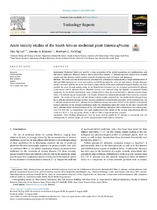| dc.contributor.author | Ng’uni, Tiza | |
| dc.contributor.author | Klaasen, Jeremy A. | |
| dc.contributor.author | Fielding, Burtram C. | |
| dc.date.accessioned | 2019-08-05T06:17:24Z | |
| dc.date.available | 2019-08-05T06:17:24Z | |
| dc.date.issued | 2018 | |
| dc.identifier.citation | Ng’Uni, T., Klaasen, J. A., & Fielding, B. C. (2018). Acute toxicity studies of the South African medicinal plant Galenia africana. Toxicology Reports, 5, 813-818. doi:10.1016/j.toxrep.2018.08.008 | en_US |
| dc.identifier.issn | 2214-7500 | |
| dc.identifier.uri | https://doi.org/10.1016/j.toxrep.2018.08.008 | |
| dc.identifier.uri | http://hdl.handle.net/10566/4759 | |
| dc.description.abstract | Background: Medicinal plants are used by a large proportion of the global population as complementary and
alternative medicines. However, little is known about their toxicity. G. africana has been used to treat wounds,
coughs and skin diseases and is used in cosmetic formulations such as lotions and shampoos.
Methods: The acute oral and dermal toxicity potential of G. africana was analyzed after a single administration of
300 and 2000 mg/kgbw for acute oral toxicity and 2000 mg/kgbw for acute dermal toxicity. Female Sprague-
Dawley rats were used for the acute oral toxicity study whereas both male and female Sprague-Dawley rats were
used for the acute dermal toxicity study. In the Episkin skin irritation test, the irritation potential of G. africana
(concentrate) and G. africana (in-use dilution) extracts were assessed using the Episkin reconstituted human
epidermis. In the dermal sensitization study, female CBA/Ca mice were treated with G. africana concentrations
of 50, 100 and 200 mg/ml respectively. The vehicle of choice was dimethylformamide which acted as a control.
Results: The results of the acute oral and dermal toxicity studies revealed that the median lethal dosage (LD50)
for G. africana extract in Sprague-Dawley rats was considered to exceed 2000 mg/kgbw. In the irritation test, the
G. africana (concentrate) and G. africana (in-use dilution) extracts were non-irritant on the Episkin reconstituted
human epidermis. In the dermal sensitization study, the stimulation index (SI) values for the mice treated with
the G. africana extract at concentrations of 50, 100 and 200 mg/ml/kgbw, when compared to the control group,
were 1.3, 0.9 and 1.3 respectively. The open application of the extract at the various concentrations did not
result in a SI of ≥ 3 in any group. Hence, it did not elicit a hypersensitivity response.
Conclusion: These findings demonstrate that the acute toxicity profile for G. africana is acceptable and can
subsequently be used for single use in the pharmaceutical and cosmetic industries. | en_US |
| dc.language.iso | en | en_US |
| dc.publisher | Elsevier | en_US |
| dc.subject | Galenia africana | en_US |
| dc.subject | Acute toxicity | en_US |
| dc.subject | Skin irritation | en_US |
| dc.subject | Episkin | en_US |
| dc.subject | Dermal sensitization | en_US |
| dc.subject | Local lymph node assay | en_US |
| dc.title | Acute toxicity studies of the South African medicinal plant Galenia africana | en_US |
| dc.type | Article | en_US |

